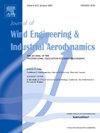Study of the applicability of different turbulence models in simulating vortex-induced vibration of a rectangular cylinder
IF 4.2
2区 工程技术
Q1 ENGINEERING, CIVIL
Journal of Wind Engineering and Industrial Aerodynamics
Pub Date : 2025-02-05
DOI:10.1016/j.jweia.2025.106031
引用次数: 0
Abstract
In this research, the practical applicability of LES, SST-DES and SST-URANS turbulence models to vortex-induced vibration (VIV) problems is investigated by employing a rectangular 5:1 cylinder as the study object. The efficacy of each model in predicting the displacement response, characterizing integrated aerodynamic forces, analyzing vortex shifting over the cylinder surface, and examining three-dimensional flow field effects is thoroughly assessed. The distribution characteristics and phase changes of aerodynamic force and flow field modes under vortex shedding frequency are analyzed based on the DMD method. All three turbulence models can accurately reproduce the lock-in phenomenon of VIV. The VIV response calculated by SST-DES is similar to experimental results and computation efficiency is improved by combining the features of LES and RANS. However, it is still challenging for SST-DES to capture the high-order vortex shedding frequency components of the flow fields in a similar manner to LES. In the SST-URANS simulation, greater work done by aerodynamic force leads to a larger steady-state amplitude. SST-URANS has difficulty in capturing small-scale vortex structures in the flow field and the main vortex location is closer to the leading edge than those obtained by LES and SST-DES. Compared with the results of LES, both SST-DES and SST-URANS overestimate the spanwise correlation of aerodynamic force, while SST-URANS weakens the three-dimensional effects of the flow fields, and the simulated vortex structure only exhibits a two-dimensional distribution. The simulation results supply data support and reference for the selection of turbulence models in the VIV simulations of prolate rectangular cylinders or bridges.
不同湍流模型在模拟矩形圆柱涡激振动中的适用性研究
本文以矩形5:1圆柱为研究对象,研究了LES、SST-DES和SST-URANS湍流模型在涡激振动(VIV)问题中的实用性。每个模型在预测位移响应、表征综合气动力、分析圆柱表面上的涡移以及检查三维流场效应方面的有效性都得到了全面的评估。基于DMD方法,分析了旋涡脱落频率下气动力和流场模态的分布特征和相变。三种湍流模型均能准确再现涡激振动的锁相现象。SST-DES计算的涡激振动响应与实验结果相似,并结合LES和RANS的特点提高了计算效率。然而,SST-DES以类似于LES的方式捕获流场的高阶涡脱落频率分量仍然具有挑战性。在SST-URANS模拟中,空气动力做的功越大,稳态振幅越大。SST-URANS难以捕捉流场中的小尺度涡结构,且主涡位置比LES和SST-DES更靠近前缘。与LES的结果相比,SST-DES和SST-URANS都高估了气动力的展向相关性,而SST-URANS则弱化了流场的三维效应,模拟的涡结构仅呈现二维分布。仿真结果为长圆柱或桥梁涡激振动仿真中湍流模型的选择提供了数据支持和参考。
本文章由计算机程序翻译,如有差异,请以英文原文为准。
求助全文
约1分钟内获得全文
求助全文
来源期刊
CiteScore
8.90
自引率
22.90%
发文量
306
审稿时长
4.4 months
期刊介绍:
The objective of the journal is to provide a means for the publication and interchange of information, on an international basis, on all those aspects of wind engineering that are included in the activities of the International Association for Wind Engineering http://www.iawe.org/. These are: social and economic impact of wind effects; wind characteristics and structure, local wind environments, wind loads and structural response, diffusion, pollutant dispersion and matter transport, wind effects on building heat loss and ventilation, wind effects on transport systems, aerodynamic aspects of wind energy generation, and codification of wind effects.
Papers on these subjects describing full-scale measurements, wind-tunnel simulation studies, computational or theoretical methods are published, as well as papers dealing with the development of techniques and apparatus for wind engineering experiments.

 求助内容:
求助内容: 应助结果提醒方式:
应助结果提醒方式:


